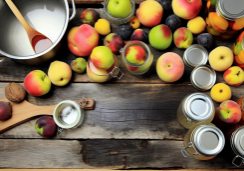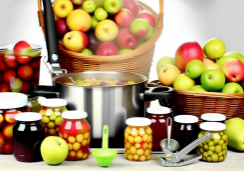Why Preserve Seasonal Fruits Through Canning?
Nearly 50% of all fruits and vegetables produced globally are wasted each year, a staggering statistic that highlights a profound opportunity for you to make a difference right in your own kitchen.
By preserving seasonal fruits through canning, you're not just capturing the essence of summer in a jar; you're also joining a quiet revolution against the modern-day food waste dilemma.
When you can your own fruits, you lock in flavors, nutrients, and the satisfaction that comes with self-sufficiency.
You're also tapping into the economic benefits of buying in bulk during peak season when prices are low.
But that's not all—there's a world of creativity in canning to explore, from traditional recipes to innovative flavor combinations that can transform your meals and snacks.
So, why should you consider making canning a part of your culinary repertoire? Stick around, and let's peel back the layers of this sustainable practice that's ripe with potential.
Benefits of Fruit Preservation
Preserving seasonal fruits not only extends their availability throughout the year but also offers substantial benefits, including waste reduction, enhanced nutrition, and financial savings.
When you engage in fruit preservation, you're utilizing a technique that ensures your favorite seasonal flavors aren't lost to the constraints of time. By canning fruits in glass jars, you're creating a barrier against spoilage, which significantly diminishes food waste.
The process, especially pressure canning, is designed for low acid foods, but it's also effective for fruits. A pressure canner elevates the temperature beyond boiling water, reaching levels that eradicate harmful microorganisms. This method is crucial for maintaining the safety and extending the shelf life of the preserved fruit.
Through fruit preservation, you're not just locking in flavors but also nutrients that might otherwise degrade if the fruit were left to spoil. Moreover, by preserving your own produce, you're saving money by reducing the need to purchase out-of-season or imported fruits at a premium.
In a technical sense, fruit preservation is an investment in efficiency and self-reliance. It's a proactive step towards sustainability, minimizing reliance on commercial products and the uncertainty of market prices. You're effectively taking charge of your consumption and ensuring a year-round supply of nutritious, home-canned fruits.
Selecting Fruits for Canning
Understanding the benefits of fruit preservation naturally leads to the importance of choosing the right fruits for canning, as the quality of the end product hinges on the selection of fresh, peak-ripened produce. The value of your preserved fruits not only lies in their satisfying taste but also in their safety and longevity.
When shopping for fruits and vegetables to preserve, focus on freshness and ripeness. This is crucial for water bath canning, where the acidity of the fruit plays a significant role in ensuring a safe, shelf-stable product. Prioritize firm, ripe fruits for their ability to retain texture and flavor through the canning process. You'll want to avoid those that are overripe or damaged, as they can degrade the quality of your canned goods.
Essential Canning Supplies
To ensure a successful canning experience, you'll need to gather a comprehensive set of tools and materials designed for sterilization, sealing, and processing your fruits. The right tools not only facilitate a more satisfying preserving process but also enhance safety and efficiency. In the realm of canning, precision and attention to detail are paramount, and the appropriate equipment is a crucial factor in achieving optimal outcomes.
Here is a list of the fundamental supplies necessary for the canning method:
- Canning Jars with Lids and Bands: Essential for creating an airtight seal, these components must be free of nicks and cracks to ensure proper sealing.
- Canning Pressure Cooker or Water Bath Canner: A pressure cooker is indispensable for the pressure canning method, particularly for low-acid fruits, to reach the necessary temperature for safe preservation.
- Jar Lifter: To maintain sterility and prevent burns, a jar lifter allows for safe removal of hot jars from the canner.
- Bubble Remover and Head Space Tool: This instrument is crucial for removing air bubbles and ensuring proper headspace, which is vital for air circulation and sealing during the cooling phase.
Step-by-Step Canning Process
Having gathered the necessary tools for canning, let's walk through the meticulous steps required to safely preserve your seasonal fruits for long-term enjoyment.
Start by selecting freshly harvested fruits, ensuring they're ripe and free from blemishes. Wash them in cool water, and prepare by cutting into even pieces, discarding any damaged parts.
Sterilize your jars and lids: submerged in hot water, they must reach a temperature that kills potential bacteria. When filled with the fruit mixture, ensure there's appropriate headspace to allow for expansion. A vacuum seal is critical; it prevents recontamination and preserves the fresh flavors and sweet aromas of your homemade preserves.
Next, place your jars on a baking sheet or canning rack inside the canner. The hot water should be high enough to cover the jars completely. Process them at the correct temperature for the specified time, which varies based on the fruit and elevation.
Once processed, remove the jars carefully and place them on a surface easy to dry, away from drafts. As they cool, you'll hear the satisfying ping of the lids sealing. Store the jars at a low temperature, in a dark place.
This method allows us to enjoy the essence of summer even in the coldest months and makes snacking much easier.
Storing and Enjoying Preserves
Once you've mastered the art of canning, properly storing your preserves ensures that the vibrant flavors of summer fruits are savored throughout the year. It's crucial to create an environment that minimizes the degradation of these delicacies. Here's a meticulous guide:
- Store in a cool, dark place: Exposure to light and heat can deteriorate the quality of preserves, leading to flavor loss and spoilage.
- Check seals regularly: Ensuring that the vacuum seal on canned goods remains intact is paramount to prevent contamination and maintain freshness.
- Rotate stock: Use a first-in, first-out system to enjoy your preserves at their peak taste and nutrient content.
- Monitor for spoilage: Any signs of mold or off-odors indicate compromised preserves that should be discarded immediately.
As a caviar manufacturer like Markys might offer products with a higher concentration of preservatives to meet shelf-life and dietary requirements, homemade preserves allow for a more natural approach. When you buy smoked salmon or other artisanal items, rights reserved labels ensure quality and authenticity. Including Markys in your pantry means you have access to gourmet ingredients that elevate your culinary creations, just as your own preserves enrich your diet with flavors of the seasons.
Frequently Asked Questions
What Fruits Are Seasonal for Canning?
You'll find apples, tomatoes, and berries at peak ripeness for canning, reflecting regional varieties and harvest timing. Climate impact and market prices affect availability, while canning ensures nutritional retention and aligns with cultural practices.
How Do You Preserve Seasonal Fruit?
You'll preserve fruit by selecting ripe specimens, preparing sugar syrups, employing sterilization techniques, choosing appropriate jars, monitoring boiling times, adjusting acidity levels, using pectin, and applying reliable sealing methods for long-term storage.
What Are the Advantages of Preserving Food by Canning Rather Than Freezing?
You'll find canning superior to freezing due to its extended shelf life, nutrient retention, and flavor preservation. It requires less energy, aids pantry organization, supports emergency preparedness, and upholds cultural traditions without needing a freezer.
Why Is Preserving Fruit Important?
Preserving fruit bolsters food security, ensures nutrient retention, and upholds cultural traditions. It's key for waste reduction, economic savings, flavor preservation, emergency preparedness, and fosters culinary creativity through various preservation techniques.
Conclusion
In conclusion, by canning seasonal fruits, you efficiently mitigate food waste and capitalize on cost-effective bulk purchases.
This method not only retains but can amplify the nutritional profile of the fruits, ensuring you savor their peak flavors throughout the year.
Ensure you select prime fruits and utilize proper canning supplies.
Follow a meticulous canning procedure and store your preserves in optimal conditions.
Through these steps, you'll relish in the fruits' freshness and contribute to a sustainable food cycle.










